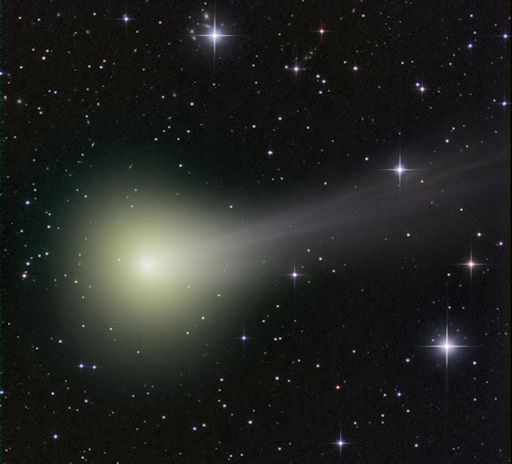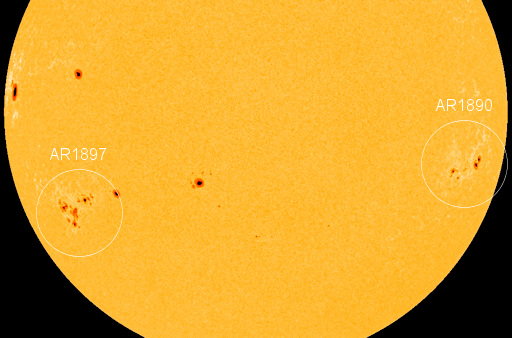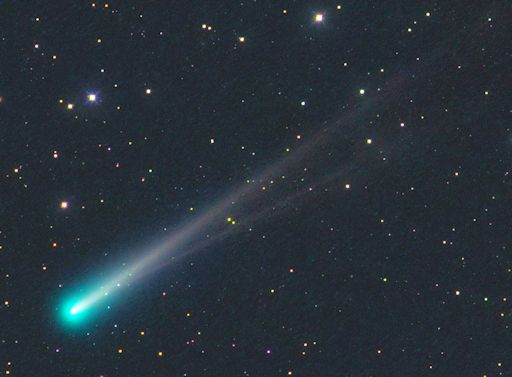When is the best time to see auroras? Where is the best place to go? And how do you photograph them? These questions and more are answered in a new book, Northern Lights - a Guide, by Pal Brekke & Fredrik Broms. | | |
WHAT WENT WRONG ON MARS? Mars was once on track to become a thriving Earth-like planet, yet today it is an apparently lifeless wasteland. A NASA spacecraft named MAVEN will soon journey to Mars to find out what went wrong on the Red Planet. Get the full story and a video from Science@NASA.
THIS COMET IS BRIGHTER THAN ISON: Comet ISON is getting all the press, but another comet is outshining the media-favorite by nearly an order of magnitude. Comet Lovejoy (C/2013 R1) is almost 10 times brighter than Comet ISON as it passes just outside the orbit of Earth in mid-November: 3D orbit. Rolando Ligustri took this picture of Comet Lovejoy on November 12th using a remotely-controlled telescope in New Mexico:

The comet's pale green atmosphere is almost twice as wide as the planet Jupiter, and there are no fewer than three tails streaming behind the comet's nucleus. Sky watchers in dark sky sites say that can now see this lovely comet as a faint smudge using averted vision--no optics required. A telescope is, however, recommended.
Comet Lovejoy is one of four comets now rising in the east before dawn. The other three are exploding Comet LINEAR X1, sungrazing Comet ISON, and short-period Comet Encke, and the brightest of them all. All four are easy targets for backyard optics. Dates of special interest include Nov. 15-18 when Comet LINEAR X1 passes by the bright star Arcturus, Nov 17-18 when Comet ISON has a close encounter with Spica, and Nov. 18-20 when Comet Encke buzzes Mercury. These stars and planets make excellent naked-eye guideposts for finding the comets. Meanwhile, bright Comet Lovejoy is approaching the Big Dipper; if you can't see it with your unaided eye, a quick scan with binoculars will reveal it. Sky maps: Nov. 13, 14, 15, 16, 17, 18, 19.
Comet ephemerides: Comet ISON, Comet Lovejoy, Comet Encke, Comet LINEAR X1
Realtime Comet Photo Gallery
WAITING FOR THE NEXT FLARE: Solar activity has been low for 24+ hours, but the forecast calls for flares. Two large, complex sunspots are transiting the Earthside of the sun with mixed-polarity magnetic fields that harbor energy for strong eruptions. The next big flare will probably come from one of these two circled regions:

NOAA forecasters estimate a 60% chance of M-class flares and a 30% chance of X-flares during the next 24 hours. Flares from AR1890 could be particularly geoeffective. Because of the way the sun's magnetic field spirals through interplanetary space, AR1890 is magnetically connected to our planet. Particles accelerated by an explosion there would be guided in our direction, possibly causing a radiation storm around Earth. Stay tuned. Solar flare alerts: text, voice
Realtime Space Weather Photo Gallery
COMET ISON SPROUTS A DOUBLE TAIL: Amateur astronomers are getting a better look at Comet ISON as it dives toward the sun for a Nov. 28th close encounter with solar fire. As the heat rises, the comet brightens, revealing new details every day. This photo, taken Nov. 10th by Michael Jäger of Jauerling Austria, shows a beautiful double tail:

One tail is the ion tail. It is a thin streamer of ionized gas pushed away from the comet by solar wind. The filamentary ion tail points almost directly away from the sun.
The other tail is the dust tail. Like Hansel and Gretel leaving bread crumbs to mark their way through the forest, ISON is leaving a trail of comet dust as it moves through the solar system. Compared to the lightweight molecules in the ion tail, grains of comet dust are heavier and harder for solar wind to push around. The dust tends to stay where it is dropped. The dust tail, therefore, traces the comet's orbit and does not point directly away from the sun as the ion tail does.
Comet ISON is currently moving through the constellation Virgo low in the eastern sky before dawn. Shining like an 8th magnitude star, it is still too dim for naked eye viewing, but an increasingly easy target for backyard optics. Amateur astronomers, if you have a GOTO telescope, enter these coordinates. Special dates of interest are Nov. 17th and 18th when the comet will pass the bright star Spica. Sky maps: Nov. 10, 11, 12, 13, 14, 15, 16, 17, 18, 19.
Realtime Comet ISON Photo Gallery
Realtime Aurora Photo Gallery
Realtime Comet ISON Photo Gallery
Every night, a network of
NASA all-sky cameras scans the skies above the United States for meteoritic fireballs. Automated software maintained by NASA's Meteoroid Environment Office calculates their orbits, velocity, penetration depth in Earth's atmosphere and many other characteristics. Daily results are presented here on Spaceweather.com.
On Nov. 12, 2013, the network reported 4 fireballs.
(4 sporadics)

In this diagram of the inner solar system, all of the fireball orbits intersect at a single point--Earth. The orbits are color-coded by velocity, from slow (red) to fast (blue). [Larger image] [movies]
Potentially Hazardous Asteroids (
PHAs) are space rocks larger than approximately 100m that can come closer to Earth than 0.05 AU. None of the known PHAs is on a collision course with our planet, although astronomers are finding
new ones all the time.
On November 13, 2013 there were potentially hazardous asteroids.
Notes: LD means "Lunar Distance." 1 LD = 384,401 km, the distance between Earth and the Moon. 1 LD also equals 0.00256 AU. MAG is the visual magnitude of the asteroid on the date of closest approach. | | The official U.S. government space weather bureau |
| | The first place to look for information about sundogs, pillars, rainbows and related phenomena. |
| | Researchers call it a "Hubble for the sun." SDO is the most advanced solar observatory ever. |
| | 3D views of the sun from NASA's Solar and Terrestrial Relations Observatory |
| | Realtime and archival images of the Sun from SOHO. |
| | from the NOAA Space Environment Center |
| | the underlying science of space weather |

